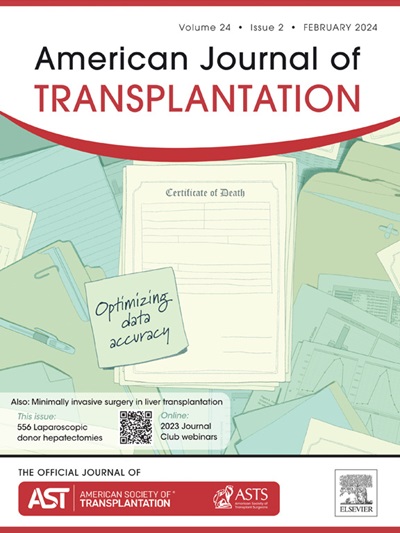Soluble CD95L is a prognostic marker in central nervous system posttransplant lymphoproliferative disorders
IF 8.2
2区 医学
Q1 SURGERY
引用次数: 0
Abstract
CD95L is a transmembrane cytokine mainly expressed by activated T and natural killer cells to contract the immune response through cell-cell contact. Conversely, after cleavage by metalloproteases, this ligand releases a soluble CD95L (sCD95L) that stimulates the immune response and its antitumor activity. In posttransplant lymphoproliferative disorders (PTLDs), we hypothesized that the concentration of sCD95L could exert a biological function and affect clinical outcomes by modulating the immune response. Using the K-VIROGREF biobank, we quantified sCD95L in 163 patients with PTLD, 16 transplant controls, and 28 healthy donors. Transplant recipients had higher plasma levels of sCD95L than healthy donors. More interestingly, patients with PTLD and high concentration of sCD95L had better clinical outcomes than patients with lower concentration, particularly those with central nervous system (CNS) involvement, who are known to have poor survival. At the cellular level, only natural killer and natural killer T-like cell fractions were reduced in the blood of patients with CNS-PTLD and high concentration of sCD95L, suggesting that sCD95L may either promote the trafficking of these cells within tumors or modulate their differentiation/survival. In conclusion, we showed in this exploratory analysis that plasma concentration of sCD95L might be a prognostic marker in patients with PTLD, particularly in those with CNS involvement.
可溶性CD95L是中枢神经系统移植后淋巴增生性疾病的预后标志物。
CD95L是一种跨膜细胞因子,主要由活化的T细胞和NK细胞表达,通过细胞间接触收缩免疫应答。相反,在金属蛋白酶裂解后,该配体释放可溶性CD95L (sCD95L),刺激免疫反应及其抗肿瘤活性。在移植后淋巴增生性疾病(PTLDs)中,我们假设sCD95L的浓度可能通过调节免疫反应发挥生物学功能并影响临床结果。使用K-VIROGREF生物库,我们量化了163例PTLD患者、16例移植对照和28例健康供者的sCD95L。移植受者的血浆sCD95L水平高于健康供者。更有趣的是,PTLD和高浓度sCD95L患者比低浓度患者有更好的临床结果,特别是那些已知有中枢神经系统(CNS)受损伤的患者生存率较低。在细胞水平上,CNS-PTLD患者血液中只有NK和nkt样细胞组分减少,sCD95L浓度高,提示sCD95L可能促进这些细胞在肿瘤内的转运或调节其分化/生存。总之,我们在这项探索性分析中表明,血浆sCD95L浓度可能是PTLD患者的预后指标,特别是在中枢神经系统受累的患者中。
本文章由计算机程序翻译,如有差异,请以英文原文为准。
求助全文
约1分钟内获得全文
求助全文
来源期刊
CiteScore
18.70
自引率
4.50%
发文量
346
审稿时长
26 days
期刊介绍:
The American Journal of Transplantation is a leading journal in the field of transplantation. It serves as a forum for debate and reassessment, an agent of change, and a major platform for promoting understanding, improving results, and advancing science. Published monthly, it provides an essential resource for researchers and clinicians worldwide.
The journal publishes original articles, case reports, invited reviews, letters to the editor, critical reviews, news features, consensus documents, and guidelines over 12 issues a year. It covers all major subject areas in transplantation, including thoracic (heart, lung), abdominal (kidney, liver, pancreas, islets), tissue and stem cell transplantation, organ and tissue donation and preservation, tissue injury, repair, inflammation, and aging, histocompatibility, drugs and pharmacology, graft survival, and prevention of graft dysfunction and failure. It also explores ethical and social issues in the field.

 求助内容:
求助内容: 应助结果提醒方式:
应助结果提醒方式:


